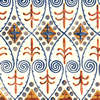| Homepage | Timeline | Maps | A-Z index | Learning |
'Applied Art'
A central problem in art history has been the definition of 'art' as an object of study. In particular, commentators have found it difficult to define boundaries between art and craft. Sometimes social distinctions are drawn, between 'high art' and 'popular art'. The term 'applied art' provides instead an interface between art and craft, as if to defuse the problem of defining art. Applied art might be defined materially as products considered by the viewer as both practical and artistic. A distinction may be sought in the training: did the person producing an object require special training, as compared with producers of other objects with the same function? It is important not to overlook problems with functional definitions: arguably, any object produced in a society has some function for that society (for example, the communicative function of a painting, or the function of a monument to express differences in personal wealth or status). Instead, it may be safer to explore the differences between objects of similar type, in the presence or absence of (1) non-figurative and (2) figurative two-dimensional motifs and three-dimensional forms. The study of 'applied art' then becomes a study of the presence or absence of motif and figure in the material products of a society.
Consider the items below within their object category, for example palettes, amulets, containers and serving spoons, surfaces in the built environment. Do you find the term 'applied art' useful in the study of these differences?
(click on the images for more information)
|
Naqada Period
|
Old Kingdom
|
Middle Kingdom |
New Kingdom |
 |